A Novel System Reliability Modeling of Hardware, Software, and Interactions of Hardware and Software
Abstract
:1. Introduction
2. Proposed Markov-based Unified System Reliability Model
2.1. System Failures Classification
2.2. Model Formulation
3. Numerical Examples
4. Conclusions
Author Contributions
Funding
Conflicts of Interest
References
- Jia, G.; Gardoni, P. State-Dependent stochastic models: A general stochastic framework for modeling deteriorating engineering systems considering multiple deterioration process and their interactions. Struct. Saf. 2018, 72, 99–110. [Google Scholar] [CrossRef]
- Yang, Q.; Zhang, N.; Hong, Y. Reliability analysis of repairable systems with dependent component failures under partially perfect repair. IEEE Trans. Reliab. 2013, 62, 490–498. [Google Scholar] [CrossRef]
- Eryilmaz, S.; Tekin, M. Reliability evaluation of a system under a mixed shock model. J. Comput. Appl. Math. 2019, 352, 255–261. [Google Scholar] [CrossRef]
- Gao, X.; Wang, R.; Gao, J.; Gao, Z.; Deng, W. A novel framework for the reliability modelling of repairable multistate complex mechanical systems considering propagation relationships. Qual. Reliab. Eng. Int. 2019, 35, 84–98. [Google Scholar] [CrossRef]
- Li, G.; Zhu, H.; He, J.; Wu, K.; Jia, Y. Application of power law model in reliability evaluation of machine tools by considering working condition difference. Qual. Reliab. Eng. Int. 2019, 35, 136–145. [Google Scholar] [CrossRef]
- Rodríguez-Borbón, M.I.; Rodríguez-Medina, M.A.; Rodríguez-Picón, L.A.; Alvarado-Iniesta, A.; Sha, N. Reliability estimation for accelerated life tests based on a Cox proportional hazard model with error effect. Qual. Reliab. Eng. Int. 2017, 33, 1407–1416. [Google Scholar] [CrossRef]
- Yi, X.J.; Shi, J.; Dhillon, B.S.; Hou, P.; Lai, Y.H. A new reliability analysis method for repairable systems with multifunction modes based on goal-oriented methodology. Qual. Reliab. Eng. Int. 2017, 33, 2215–2237. [Google Scholar] [CrossRef]
- Park, J.; Baik, J. Improving software reliability prediction through multi-criteria based dynamic model selection and combination. J. Syst. Softw. 2015, 101, 236–244. [Google Scholar] [CrossRef]
- Lung, C.H.; Zhang, X.; Rajeswaran, P. Improving software performance and reliability in a distributed and concurrent environment with an architecture-based self-adaptive framework. J. Syst. Softw. 2016, 121, 311–328. [Google Scholar] [CrossRef]
- Wang, S.; Wu, Y.; Lu, M.; Li, H. Discrete nonhomogeneous Poisson process software reliability growth models based on test coverage. Qual. Reliab. Eng. Int. 2013, 29, 103–112. [Google Scholar] [CrossRef]
- Zhu, M.; Pham, H. A two-phase software reliability modeling involving with software fault dependency and imperfect fault removal. Comput. Lang. Syst. Struct. 2018, 53, 27–42. [Google Scholar] [CrossRef]
- Zhu, M.; Pham, H. A software reliability model incorporating martingale process with gamma-distributed environmental factors. Ann. Oper. Res. 2018, 1–22. [Google Scholar] [CrossRef]
- Iyer, R.K.; Velardi, P. Hardware-Related software errors: Measurement and analysis. IEEE Trans. Softw. Eng. 1985, 2, 223–231. [Google Scholar] [CrossRef]
- Why Email Fails: Message One Survey of Email Outages. Available online: http://www.disaster-resource.com/articles/ems_whitepaper_why_emls_fail.pdf (accessed on 5 August 2019).
- Huang, B.; Rodriguez, M.; Li, M.; Bernstein, J.B.; Smidts, C.S. Hardware error likelihood induced by the operation of software. IEEE Trans. Reliab. 2011, 60, 622–639. [Google Scholar] [CrossRef]
- Laprie, J.C. Dependable computing and fault-tolerance: Concepts and terminology. In Proceedings of the IEEE FTCS-15, Ann Arbor, MI, USA, 19–21 June 1985. [Google Scholar]
- Shapiro, F.R. Etymology of the computer bug: History and folklore. Am. Speech. 1987, 62, 376–378. [Google Scholar] [CrossRef]
- Huang, B.; Rodriguez, M.; Bernstein, J.; Smidts, C. Software reliability estimation of microprocessor transient faults. In Proceedings of the 42nd AIAA/ASME/SAE/ASEE Joint Propulsion Conference & Exhibit, Sacramento, CA, USA, 9–12 July 2006. [Google Scholar]
- Huang, B. Study of the Impact of Hardware Failures on Software Reliability; University of Maryland: College-Park, MD, USA, 2006. [Google Scholar]
- Goswami, K.K.; Iyer, R.K. Simulation of software behavior under hardware faults. In Proceedings of the 23rd International Symposium on Fault-Tolerant Computing, Toulouse, France, 22–24 June 1993. [Google Scholar]
- Huang, B.; Li, X.; Li, M.; Bernstein, J.; Smidts, C. Study of the impact of hardware fault on software reliability. In Proceedings of the 16th IEEE International Symposium on Software Reliability Engineering (ISSRE’05), Chicago, IL, USA, 8–11 November 2005. [Google Scholar]
- Teng, X.; Pham, H.; Jeske, D.R. Reliability modeling of hardware and software interactions, and its applications. IEEE Trans. Reliab. 2006, 55, 571–577. [Google Scholar] [CrossRef]
- Hecht, H.; Hecht, M. Software reliability in the system context. IEEE Trans. Softw. Eng. 1986, 1, 51–58. [Google Scholar] [CrossRef]
- Friedman, M.A.; Tran, P. Reliability techniques for combined hardware/software systems. In Proceedings of the Annual Reliability and Maintainability Symposium, Las Vegas, NV, USA, 21–23 January 1992. [Google Scholar]
- Welke, S.R.; Johnson, B.W.; Aylor, J.H. Reliability modeling of hardware/software systems. IEEE Trans. Reliab. 1995, 44, 413–418. [Google Scholar] [CrossRef]
- Park, J.; Kim, H.J.; Shin, J.H.; Baik, J. An embedded software reliability model with consideration of hardware related software failures. In Proceedings of the 2012 IEEE Sixth International Conference on Software Security and Reliability, Gaithersburg, MD, USA, 20–22 June 2012. [Google Scholar]
- Zeng, Y.; Xing, L.; Zhang, Q.; Jia, X. An analytical method for reliability analysis of hardware-software co-design system. Qual. Reliab. Eng. Int. 2019, 35, 165–178. [Google Scholar] [CrossRef]
- Bar-Yam, Y. Dynamics of Complex Systems; Addison-Wesley: Boston, MA, USA, 1997. [Google Scholar]
- Yang, G. Life Cycle Reliability Engineering; Wiley: Hoboken, NJ, USA, 2007. [Google Scholar]
- Elsayed, E.A. Reliability Engineering; John Wiley & Sons: Hoboken, NJ, USA, 2012. [Google Scholar]
- Song, S.; Coit, D.W.; Feng, Q.; Peng, H. Reliability analysis for multi-component systems subject to multiple dependent competing failure processes. IEEE Trans. Reliab. 2014, 63, 331–345. [Google Scholar] [CrossRef]
- Pham, H. System Software Reliability; Springer: Berlin, Germany, 2007. [Google Scholar]
- Ross, S.M. Introduction to Probability Models; Academic Press: Cambridge, MA, USA, 2014. [Google Scholar]
- Kulkarni, V.G. Modeling and Analysis of Stochastic Systems; Chapman and Hall/CRC: Boca-Raton, FL, USA, 2016. [Google Scholar]
- Goel, A.L.; Okumoto, K. Time-Dependent error-detection rate model for software reliability and other performance measures. IEEE Trans. Reliab. 1979, 28, 206–211. [Google Scholar] [CrossRef]
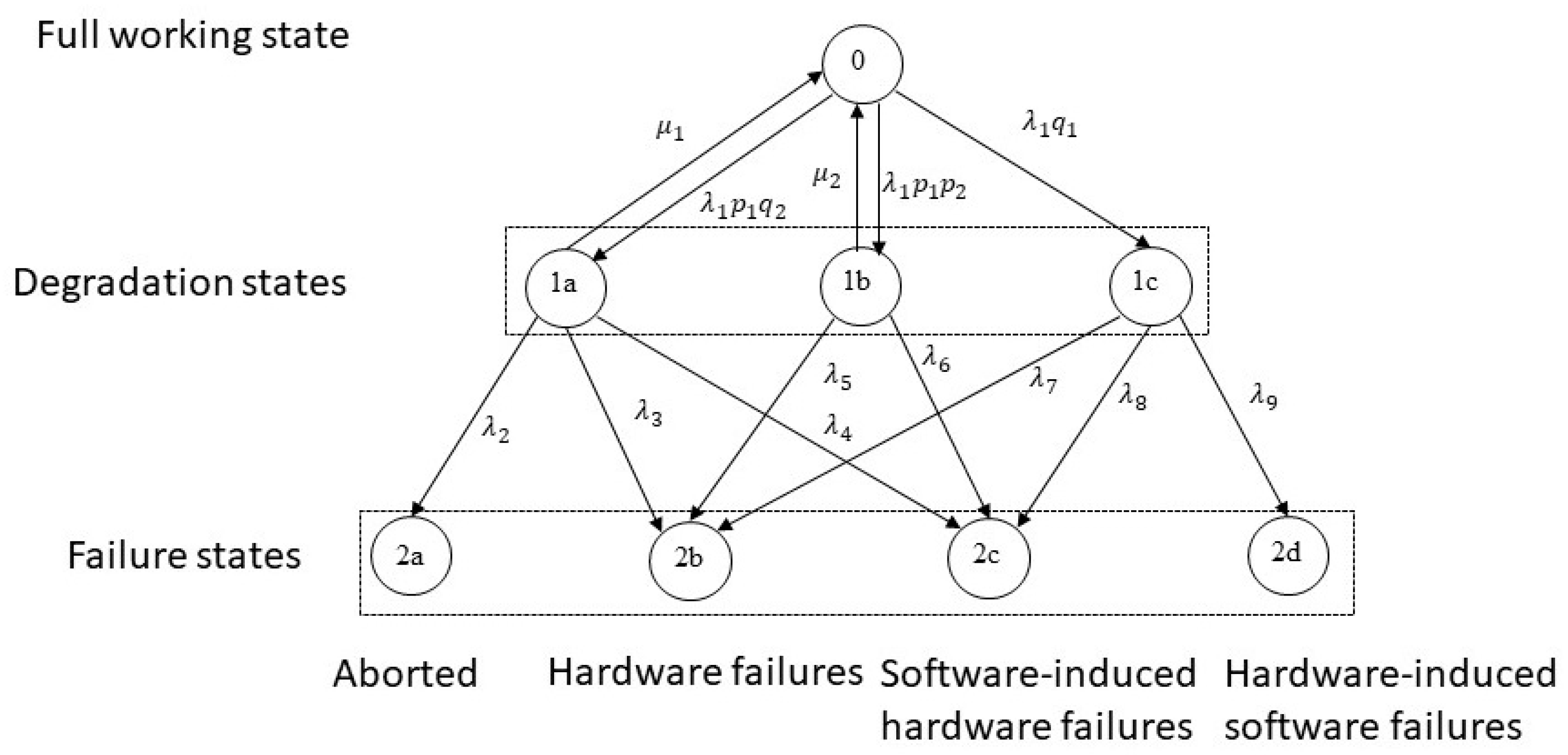
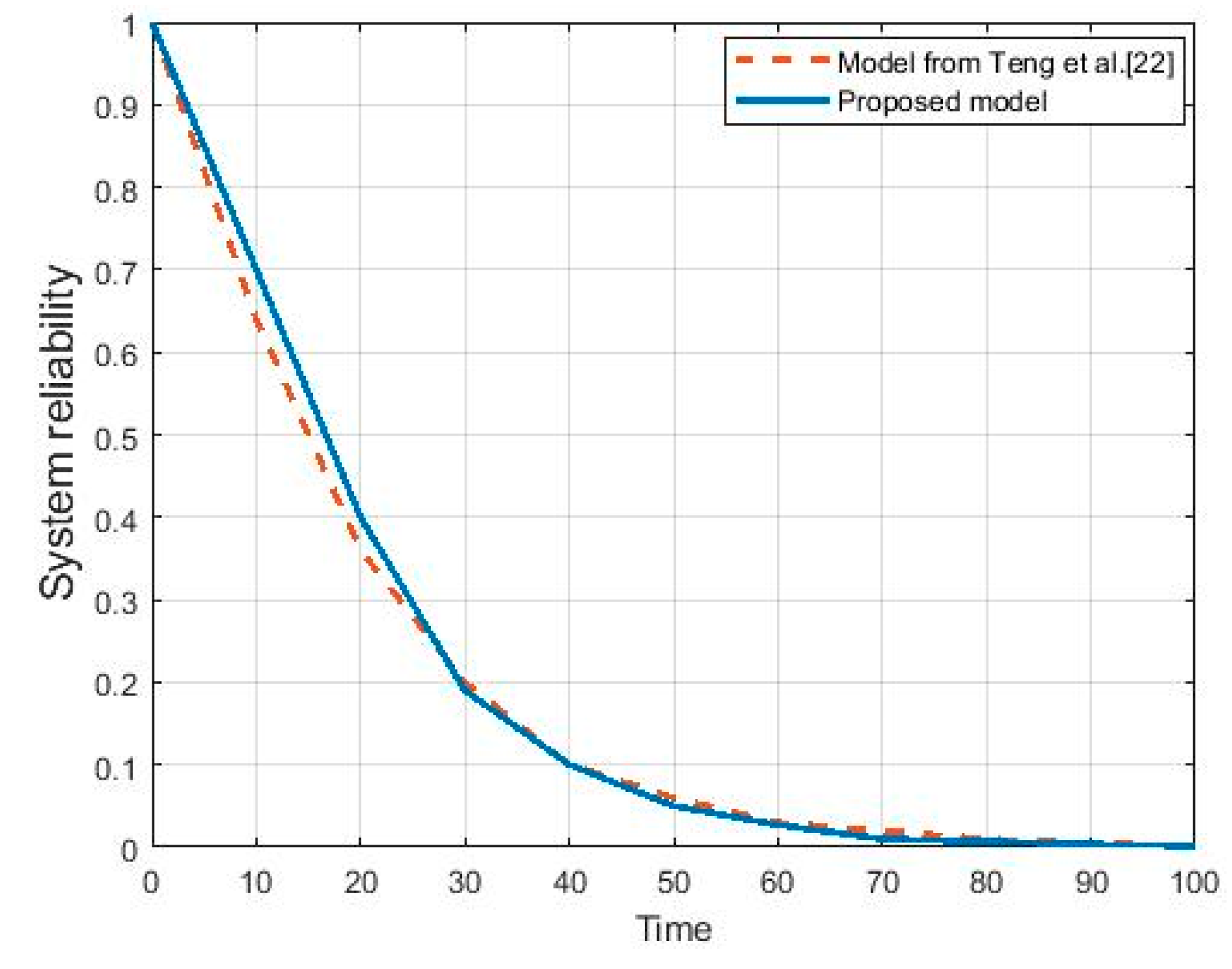
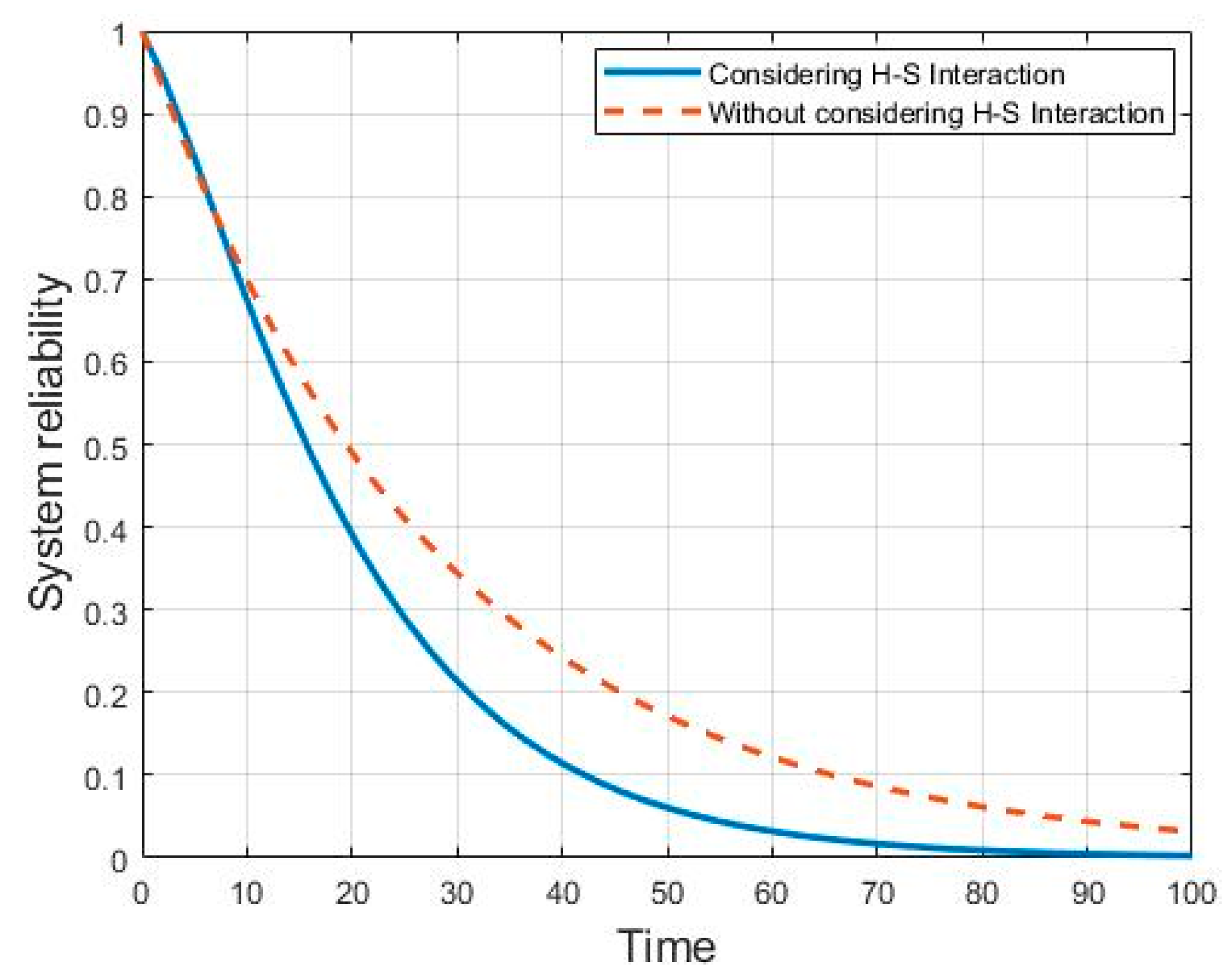
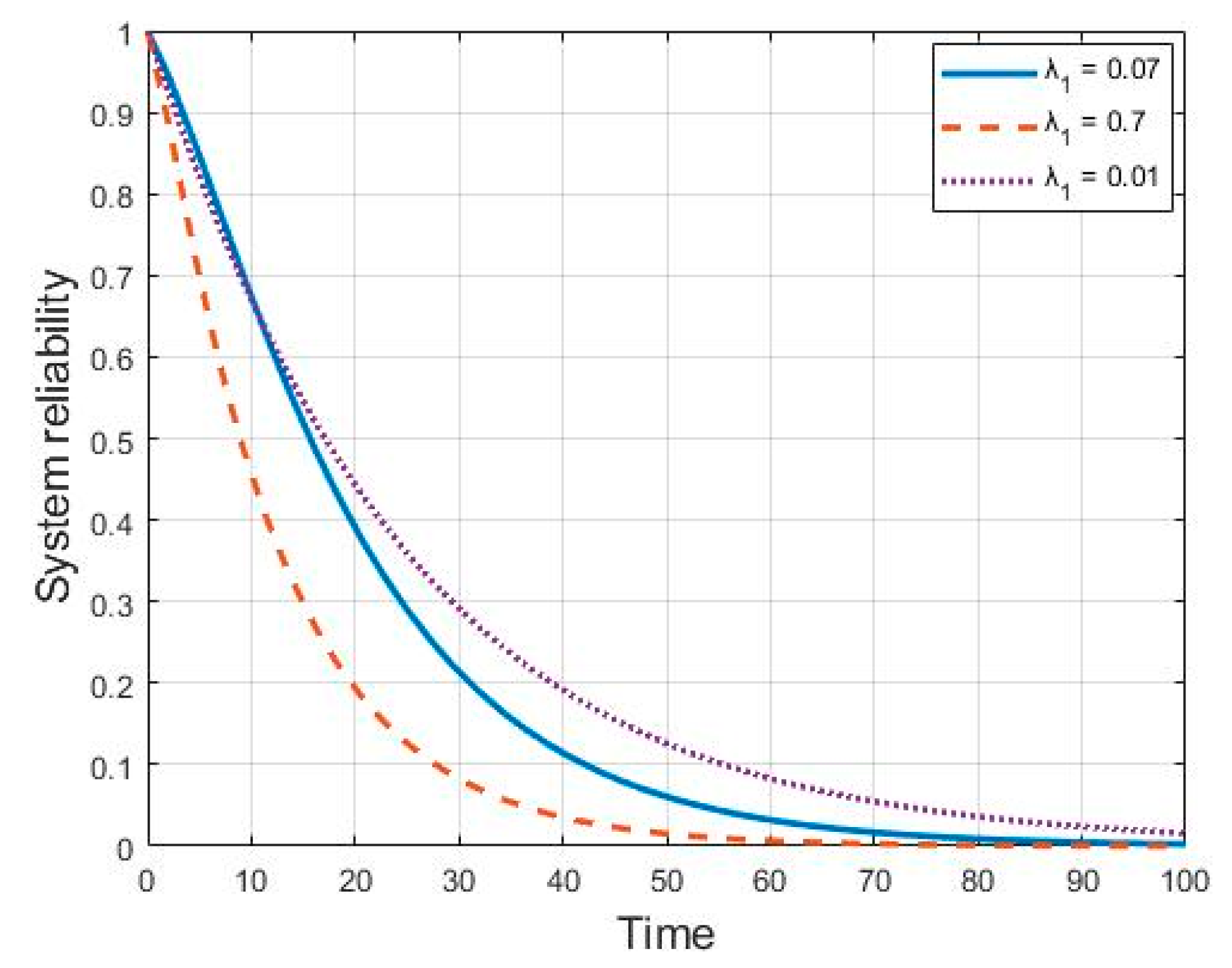
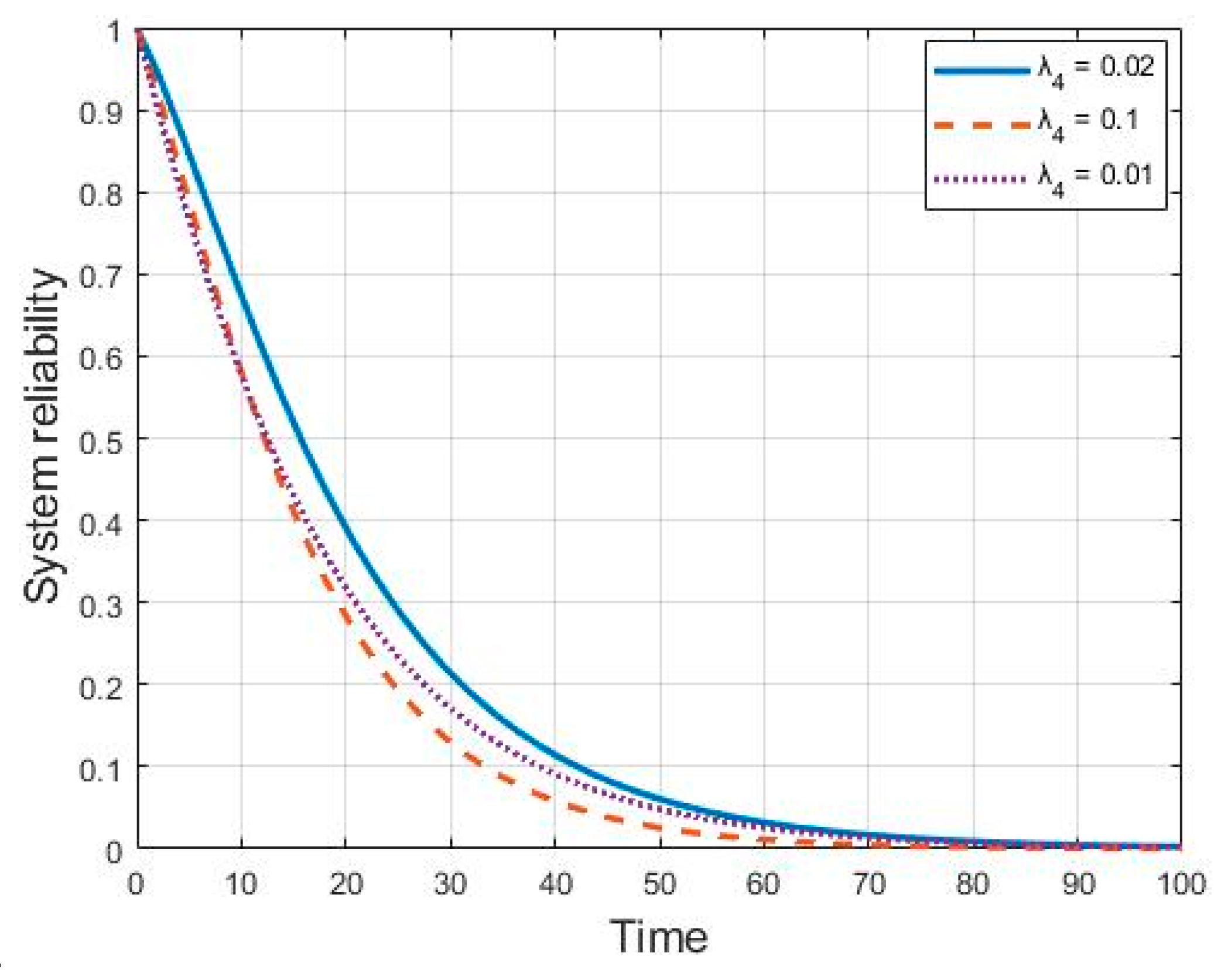
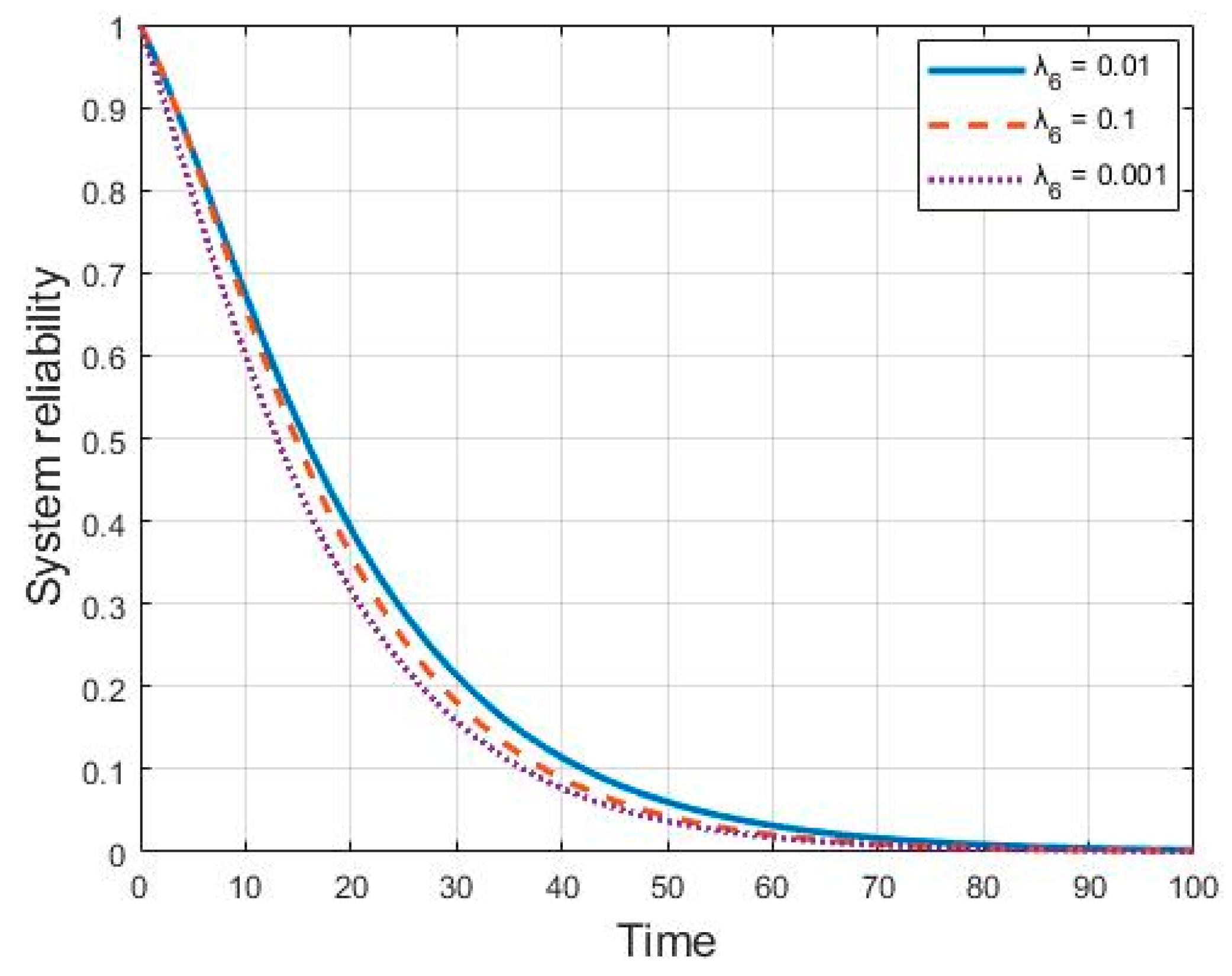
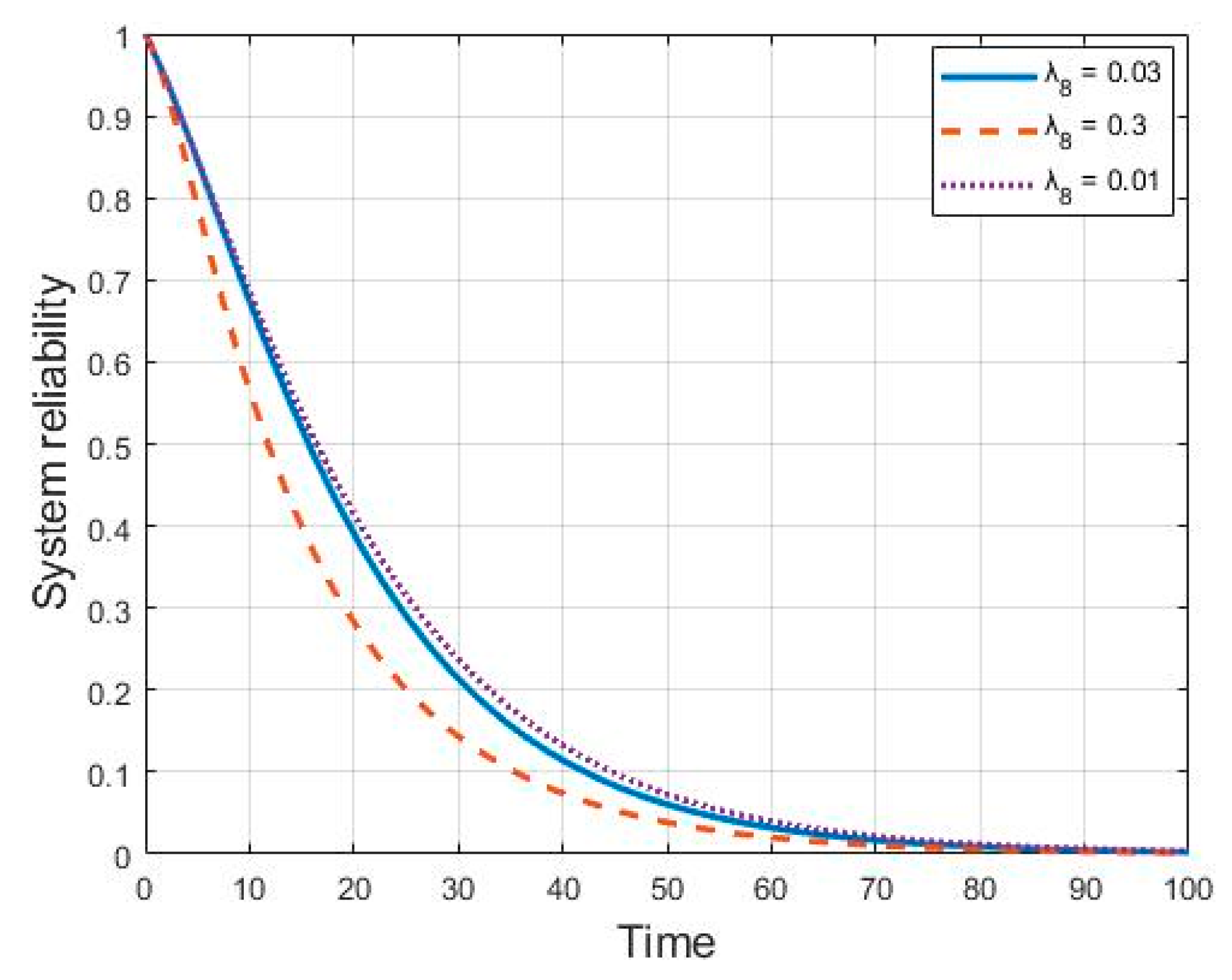
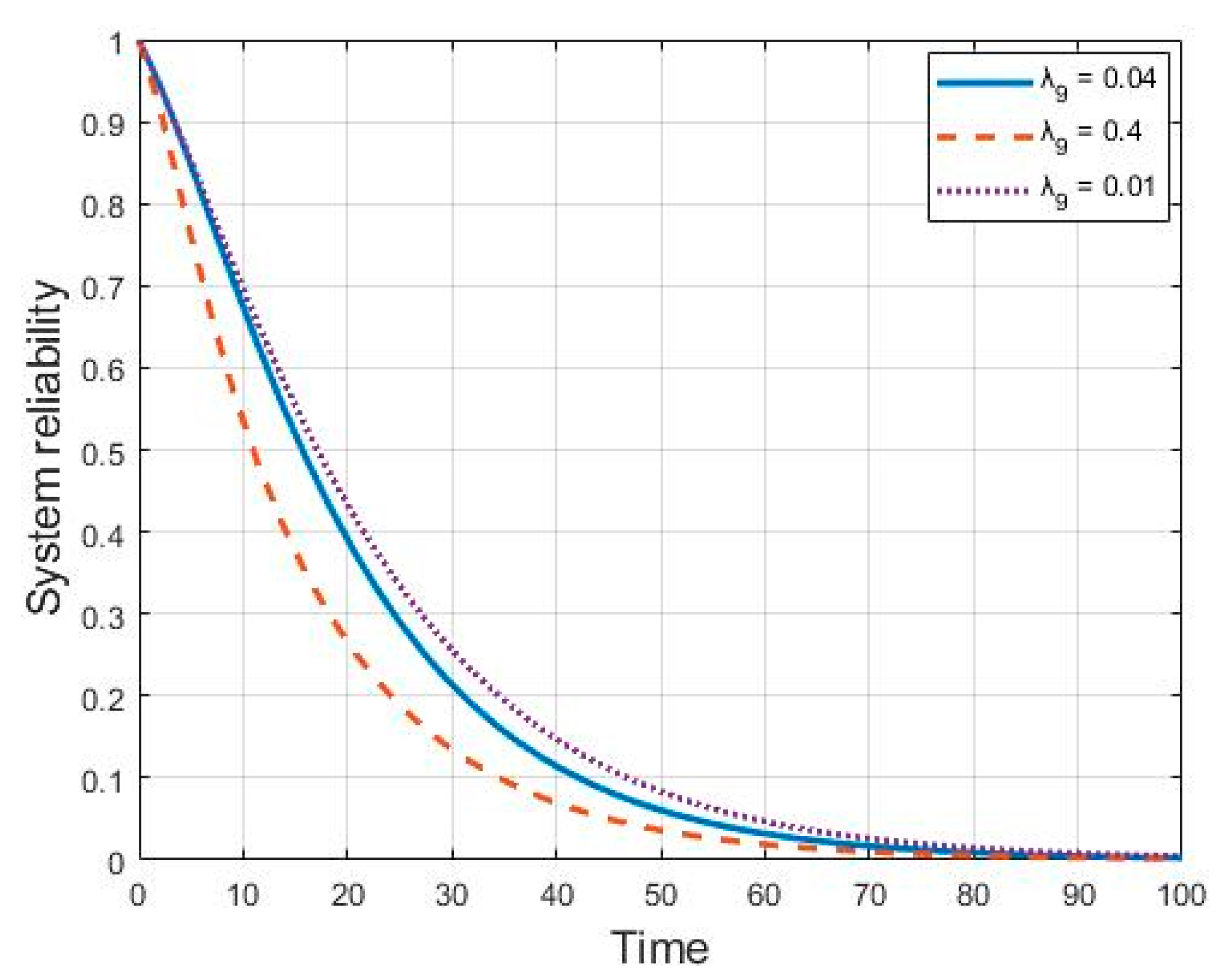
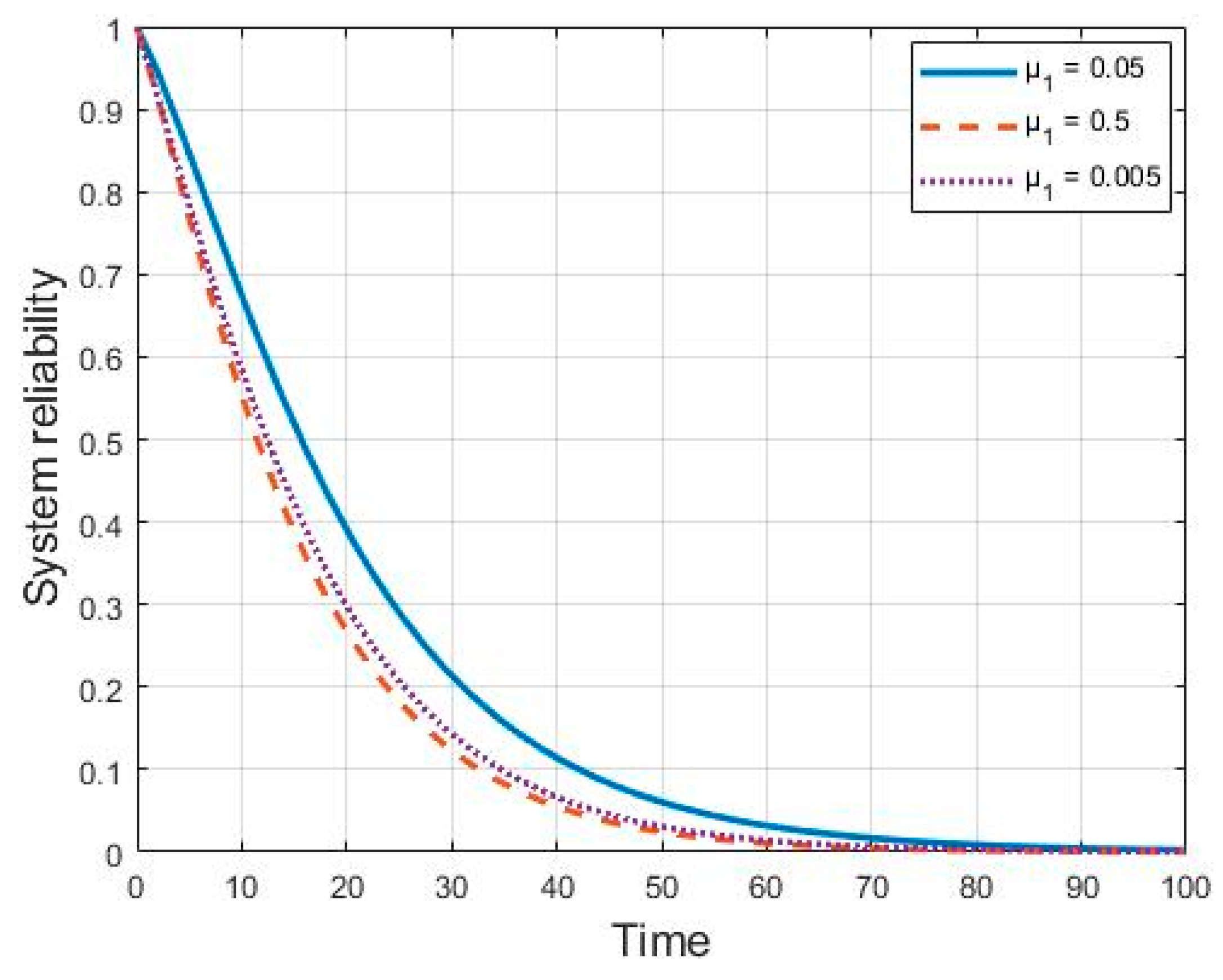
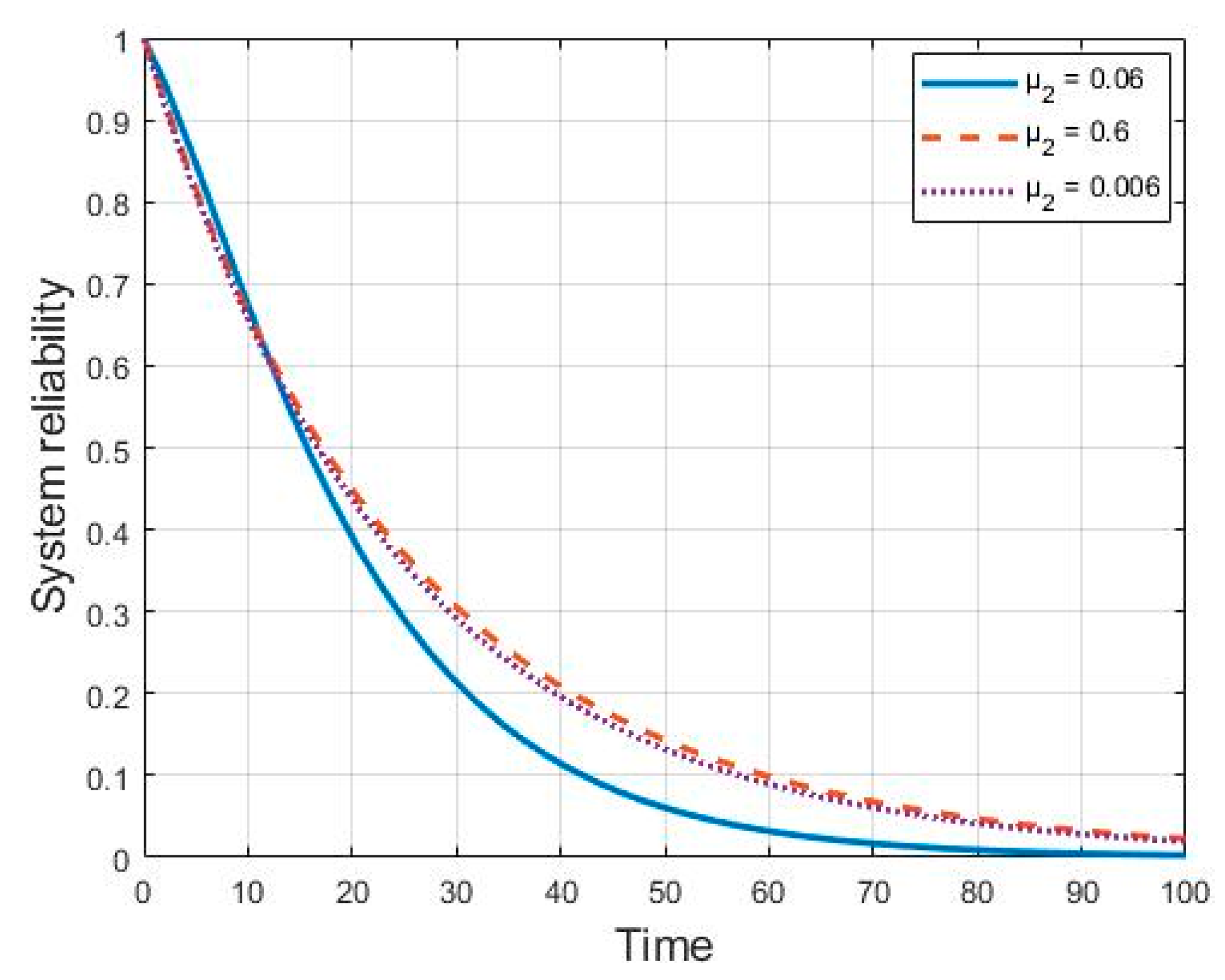
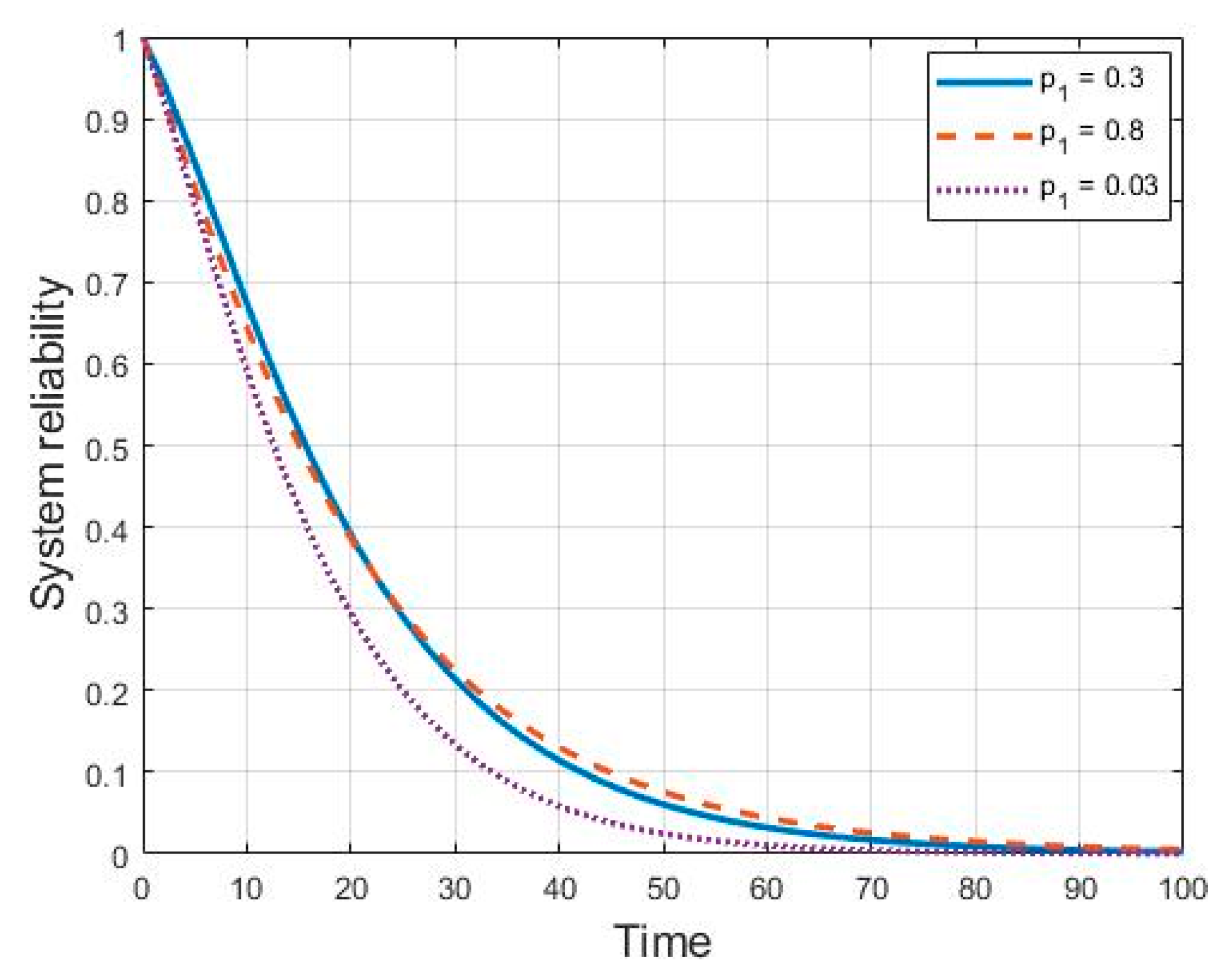
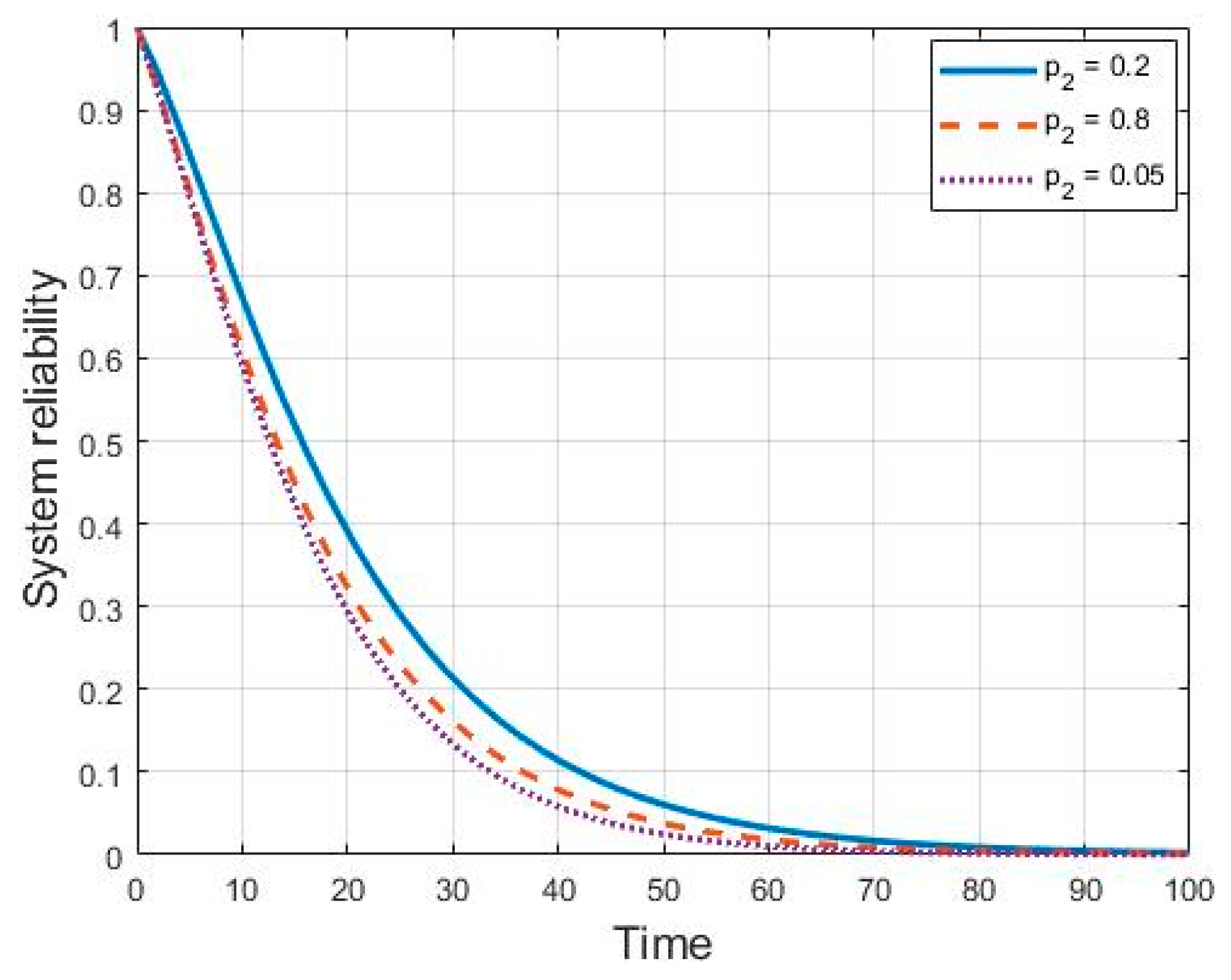
| Set | λ1 | λ4 | λ6 | λ8 | λ9 | μ1 | μ2 | p1 | p2 |
|---|---|---|---|---|---|---|---|---|---|
| 0.07 | 0.02 | 0.01 | 0.03 | 0.04 | 0.05 | 0.06 | 0.3 | 0.2 | |
| 0.7 | 0.02 | 0.01 | 0.03 | 0.04 | 0.05 | 0.06 | 0.3 | 0.2 | |
| 0.01 | 0.02 | 0.01 | 0.03 | 0.04 | 0.05 | 0.06 | 0.3 | 0.2 | |
| 0.07 | 0.1 | 0.01 | 0.03 | 0.04 | 0.05 | 0.06 | 0.3 | 0.2 | |
| 0.07 | 0.01 | 0.01 | 0.03 | 0.04 | 0.05 | 0.06 | 0.3 | 0.2 | |
| 0.07 | 0.02 | 0.1 | 0.03 | 0.04 | 0.05 | 0.06 | 0.3 | 0.2 | |
| 0.07 | 0.02 | 0.001 | 0.03 | 0.04 | 0.05 | 0.06 | 0.3 | 0.2 | |
| 0.07 | 0.02 | 0.01 | 0.3 | 0.04 | 0.05 | 0.06 | 0.3 | 0.2 | |
| 0.07 | 0.02 | 0.01 | 0.01 | 0.04 | 0.05 | 0.06 | 0.3 | 0.2 | |
| 0.07 | 0.02 | 0.01 | 0.03 | 0.4 | 0.05 | 0.06 | 0.3 | 0.2 | |
| 0.07 | 0.02 | 0.01 | 0.03 | 0.01 | 0.05 | 0.06 | 0.3 | 0.2 | |
| 0.07 | 0.02 | 0.01 | 0.03 | 0.04 | 0.5 | 0.06 | 0.3 | 0.2 | |
| 0.07 | 0.02 | 0.01 | 0.03 | 0.04 | 0.005 | 0.06 | 0.3 | 0.2 | |
| 0.07 | 0.02 | 0.01 | 0.03 | 0.04 | 0.05 | 0.6 | 0.3 | 0.2 | |
| 0.07 | 0.02 | 0.01 | 0.03 | 0.04 | 0.05 | 0.006 | 0.3 | 0.2 | |
| 0.07 | 0.02 | 0.01 | 0.03 | 0.04 | 0.05 | 0.06 | 0.8 | 0.2 | |
| 0.07 | 0.02 | 0.01 | 0.03 | 0.04 | 0.05 | 0.06 | 0.03 | 0.2 | |
| 0.07 | 0.02 | 0.01 | 0.03 | 0.04 | 0.05 | 0.06 | 0.3 | 0.8 | |
| 0.07 | 0.02 | 0.01 | 0.03 | 0.04 | 0.05 | 0.06 | 0.3 | 0.05 |
© 2019 by the authors. Licensee MDPI, Basel, Switzerland. This article is an open access article distributed under the terms and conditions of the Creative Commons Attribution (CC BY) license (http://creativecommons.org/licenses/by/4.0/).
Share and Cite
Zhu, M.; Pham, H. A Novel System Reliability Modeling of Hardware, Software, and Interactions of Hardware and Software. Mathematics 2019, 7, 1049. https://doi.org/10.3390/math7111049
Zhu M, Pham H. A Novel System Reliability Modeling of Hardware, Software, and Interactions of Hardware and Software. Mathematics. 2019; 7(11):1049. https://doi.org/10.3390/math7111049
Chicago/Turabian StyleZhu, Mengmeng, and Hoang Pham. 2019. "A Novel System Reliability Modeling of Hardware, Software, and Interactions of Hardware and Software" Mathematics 7, no. 11: 1049. https://doi.org/10.3390/math7111049
APA StyleZhu, M., & Pham, H. (2019). A Novel System Reliability Modeling of Hardware, Software, and Interactions of Hardware and Software. Mathematics, 7(11), 1049. https://doi.org/10.3390/math7111049




